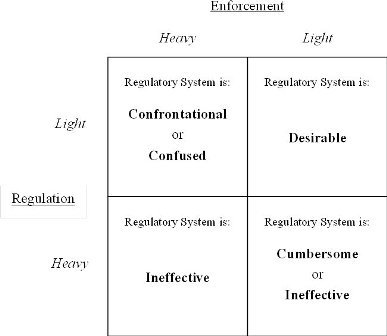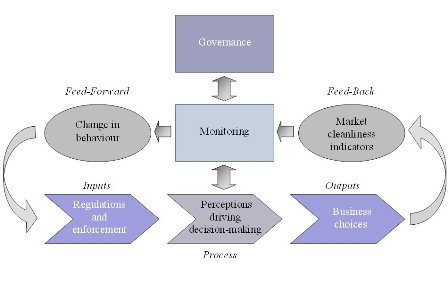Regulatory Effectiveness Study
Background & Proposal
The recent world-wide instability of financial and credit markets and the resulting collapse and consolidation of the banking and investment sectors breaks long-standing assumptions about capital dynamics and the effectiveness of national and international enforcement and regulatory systems. Because of the scale of the crisis and associated losses, national governments are reviewing options for response and longer-term changes necessary to prevent another systemic collapse.
Z/Yen sees the regulatory system as having two component parts: administration (which is comprised of the legislative framework and business compliance), and enforcement (which includes monitoring, intervention and, where necessary, prosecution). Recommendations on improving global regulatory systems rely on a two-fold process: first, clearly understanding the multivariate nature of the roots and triggers of the crisis and collapse, and second, identifying specific regulations and enforcement options as key to moving forward into a new domestic and international financial regime.
There are, as pointed out in Professor John Coffee’s paper “Law and the Market: the Impact of Enforcement” (December ’07), and the follow-on analysis by Professor Eilis Ferran in “Capital Market Competitiveness and Regulation” (March ’08), two variables at play – regulation and enforcement. We note that the most desirable combination is when regulation is light, appropriate, and effective at setting standards, and therefore the need for enforcement is minimal. Other combinations may prove confrontational, confused, cumbersome, or ineffective, as illustrated in the following chart:

Z/Yen sees the relationship between the regulators and the regulated (who constantly influence each other, and both influence and are influenced by the market - their ‘environment’) as co-evolutionary. In biology, the environment within which interdependence take place is described as a ‘fitness landscape’. The Nobel Prize winning physicist Murry Gell-Mann compares the environment to the market in his book, The Quark and the Jaguar (page 256):
“The analogy between an ecological community and a market economy is relevant to the connection [between ‘fitness’ and optimum survivability]. As opportunities for making a profit arise in such an economy, individuals or firms are likely (though by no means certain) to come along to take advantage of them. The analogue of death in this case is going broke, and wealth instead of population is a crude measure of the fitness of a firm.
In both economics and ecology, the advent of a new business or a new organism (or a new type of behaviour in an existing firm or organism) will alter the fitness landscape for the other members of the community. From the point of view of the business or a species, that landscape is constantly changing (besides not being altogether well defined in the first place.)”
Evaluating an ecology requires an understanding of the interdependencies that create fitness.
Z/Yen will identify international practices and examples of the co-evolutionary relationship between regulatory administration & enforcement with markets. Our analysis will try to identify which factors have maximised market success while minimising regulatory overhead and the necessity of enforcement. The deliverables of this study would be a substantial research paper of publishable quality, and a public presentation of its findings.
Methodology
Capital markets, businesses, and regulatory authorities make up a complex, interdependent system defined not only by the nature of each component part, but also by the relationships between them, and unique characteristics that only emerge from interactions of the whole. Understanding a system first requires understanding its elements and our basic model is based on Beer’s viable systems model:

- Inputs – sources of energy or resources in the system;
The number and quality of national (and, where applicable, international) regulations and enforcement mechanisms [metrics include: national datasets (e.g. British Chambers of Commerce ‘Burdens Barometer’), publications and data from the BIS, ICMA, ISDA, LIBA, SEC, World Bank, IMF, EU-US Coalition, as well as UK National Audit Office (NAO), Department for Business, Enterprise & Regulatory Reform (BERR), Better Regulation Executive (BRE) and their equivalents in other key countries/jurisdictions of the study]
- Process – change and growth (positive or negative);
Perceptions of the mechanisms, variables, and cost of raising capital by business [metrics include: data from guided interviews of business and finance executives in relevant countries, plus quantitative data gathered through companion on-line survey]
- Outputs – products and by-products of the process;
Specific business decisions, including the choices on company listing/delisting, investment fund management, treating customers fairly, mergers and acquisitions [metrics include: data from guided interviews of business and finance executives in relevant countries, plus quantitative data gathered through companion on-line survey, relevant national datasets]
- Feed-Back – reaction of the system to the outputs;
Overall market cleanliness [metrics include: analysis of national-level Informed Price Movements (IPMs or equivalent) mechanisms, capital raising practices, investment decisions, retail investor experience, their bases for measurement, and levels of implementation]
- Monitoring – measurement of the process;
National and international enforcement regimes [metrics include: relevant literature and research, relevant external datasets of enforcement levels, effectiveness]
- Feed-Forward – adjustments in anticipation of, or to create specific change;
Market and government reactivity to perceived and actual changes, risk, and instability [metrics include: data from guided interviews]
- Governance – setting the system to meeting a goal;
National legislative and executive oversight bodies, and possibly civil society [metrics include: relevant literature and research in mutual recognition standards, external datasets on perceived and actual incidents of enforcement]
Z/Yen will consider each of these components, and use the overall system model to frame the project’s approach and analytical work, drawing on a variety of data sources detailed below.
Approach
Z/Yen would approach the overall project as follows:
- Establish Endeavour – ensure we understand the problem(s) and stakeholders’ needs;
- Assess & Appraise – gather knowledge on severity and benefit of impacts;
- Lookaheads & Likelihoods – evaluate scenarios and frequency of occurrence;
- Options & Outcomes – lay out responses for a decision;
- Understanding & Undertaking – conclusions;
- Securing & Scoring – evaluate and publish.
Next Steps
Z/Yen would welcome further discussion with interested parties about how the research ideas in this document might be developed and funded.